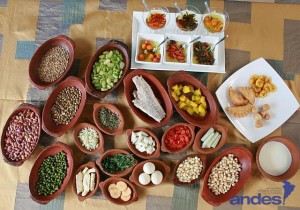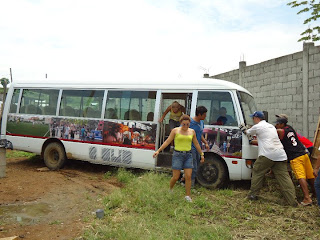In land area Ecuador is one of the smallest countries in Latin America. However, when it comes to political unrest, cultural diversity, urban concentration, and rich natural resources, it proves one of the most interesting and controversial countries in Latin America. One of the largest problems in Ecuador is the huge cleavage that exists between the rural and urban people of the country. Ecuador is polarized with two main city centers: Guayaquil and Quito. These two cities control almost every aspect of Ecuadorian life. Quito is center of politics and conservatism while Guayaquil functions as the center of trade and liberalism. The two centers also represent the difference between the people of the coast and the Sierra respectively.
I know that I have talked briefly about the problem of poverty on this blog before but I don’t think I have adequately addressed the effect that rural to urban migration is having on the economy or the desperate lack of housing.

Land rights have been a problem in Ecuador since the Colonial times. The indigenous obviously never used deeds or titles to land so when the Spanish came over, who owned what was all left in a big mess. A lot of this is still going on today. For example, in my Ecuadorean culture class last night, my Professor was telling us about a farm he used to own. He explained to us how he was in the process of restoring an ancient bamboo house that was on the property until his “farm was invaded.” When I prompted him farther about what he meant about the invasion of his property he explained that about 500 Indians had dumped their stuff on the land and begin to build shacks and farms. Apparently this type of land invasion still happens on a regular basis and there isn’t much that you can do about it. It is virtually impossible to kick out 500 Indians on your own and the government has enough problems to deal with it so it takes no action.
Anyway, the point is that the poor from the country side have been migrating in to the outskirts of Guayaquil in search for better economic opportunities. They often arrive to Guayas with absolutely nothing to call their own and they simply pick a spot of land and move in. The current government has established regulation that if a family has been living on the lot for five years or longer the land becomes automatically theirs. These areas of town typically surround the city and are often a collection of ramshackle huts and bamboo houses with dirt floors and no running water or electricity.
Well this past Saturday morning I woke up in my nice little bed in my own room and walked downstairs to eat a freshly prepared breakfast (patacones, my favorite! Leonor always cooks these for me when she knows I have to miss lunch at home because it’s a hearty breakfast and I don’t think she trusts other people to feed me enough!) An hour later I found myself in a reality so drastically different that I felt like I had fallen down a rabbit hole.
Welcome to Monte Sinai on the Pereneal Norte area of Guayaquil. It is a main highway on the outskirts of the city. As soon as the road was built people started invading and settling down in neighborhoods. The entire neighborhood is filled to the brim with dirt, bamboo houses, trash, unpaved roads and standing water. The roads were especially bad that day because we had a strong rain storm the night before.
We were there with a volunteer foundation called Hogar del Cristo. Hogar del Cristo is a huge organization that was founded in Chile and works with the extreme poor to provide shelter, education, and micro credit loans to help the poor start small businesses to improve their situations. We were scheduled to build two houses. The houses are made of bamboo and last about 5 to 6 years if they are well taken care of. They have to be built on stilts off the ground because the land is swampy. They generally consist of one room and often end up holding up to 6 or 7 people. They have no plumbing and no electricity, but they do provide a little shelter and security for the families.

We started with nothing but an empty little plot of land. The first phase of construction was digging nine base holes, about 1 meter deep, to serve as the foundation for the house. We grabbed some shovels and went at it. After lots of sun screen applications, sweat, and mud throwing we began to actually put in the posts. We had a carpenter helping us out to make sure that the houses remained level and would be sturdy at the end. Next came the floors.
The walls were pre-assembled by Hogar del Cristo and simply had to be attached and nailed in. Then came the “stairs,” the roof, and the doors and the windows.
But the truth is I only helped with the digging of the post holes (although that did take almost the whole morning). At about noon our director asked us if anyone would go with the future family of the house and help to prepare lunch for the entire group. I really wanted to get to know the family and was automatically interested in the idea of cooking with them so I was the first one to volunteer.
The first step of lunch preparation was a trip to the market.
We collected one dollar from each volunteer, which left us with about 30 dollars to make lunch for 40 people (we didn’t charge the families of course). I was a little worried it wouldn’t stretch.
But before we could even leave the site we got stuck in the mud due to the poor road conditions and ended up having to get back off the bus and dig/push the bus out.
Anyway, once we were on the road again we headed down to the market of the little barrio (neighborhood). I was covered in mud and sweat, but apparently my blond hair and obvious gringa appearance still wasn’t hidden because the people in the market looked at me like I had three heads. The grandma of the family immediately rushed in and started barking orders to the sales people asking for chicken. They pulled out three freshly killed chickens with the heads still intact and the necks sliced open where the blood had been drained out. On top of the three huge chunks of rotting flesh we bought a huge bundle of sweet plantains, a few pounds of rice, some menestra, vegetables, and fried eggs. The total came out to $25.80. We spent the last few dollars to buy some Cola to drink and headed back to the grandma’s house to cook.

Upon entering the grandma’s house it became apparent that the entire family must have been taking shelter there while they were lacking housing. There were two beds along the walls of one room with a tiny stove area against the other wall and a refrigerator squeezed in. Extra blankets were thrown everywhere that I’m assuming served as beds on the floor. If you exited through the back door there was a tiny closet size shack where there was a hole in the ground for the bathroom. Allow me to introduce you to our family… The older lady to the right in the picture is the grandma who already had a house. The lady holding the baby is a mother of five and she is who we were building the house for.
We spent the next hour or so picking out stones and debris from the rice, chopping vegetables, and slicing and frying the sweet plantains. We made a traditional Ecuadorian dish called Seco de Pollo with rice and maduro, and then lentils, rice, and fried eggs, for the vegetarians. Once the seco de pollo was cooking we had some free time to hang out with the family.
One of the little girls was sitting on the bed trying to get her shoe on. I asked her if she needed help. She didn’t answer me, she just looked up at me, got a huge smile on her face and immediately ran straight at me and fell in my arms to give me a huge hug. Her name is Arriana and she is three years old (although she thinks it’s hilarious to try to trick you and tell you she is only two). She is the youngest girl in their family of 5 children. We eventually got both of her shoes on and she became my best friend for rest of the day.

Arriana was quick to introduce me to her youngest brother, Mathius. Mathius is six months old. The other girls in the house take turns playing with him and making him smile. I think he is their favorite toy. The oldest girl, around 8 I think was in charge of watching him almost full time. At first glance he seems like the ideal baby. He is extremely calm, never cries, and the only reaction you see him make is the occasional smile. After playing with Mathius and holding him for a while I started to wonder about his development level. I could feel his rib bones sticking out on his sides and his cheeks were thin and almost sunken, far from the fat cheeks of a Gerber baby. I quickly begin to suspect that his calm demeanor was the result of a lack of reactionary capabilities rather than a personality trait. He made no movement to new people and didn’t seem to notice people tickling his feet or touching him at all.

The electricity in the Grandmas house went out in the middle of cooking lunch. No one seemed extremely concerned as I suppose it is a common occurrence. It came back on after a few minutes and we just kept going. Once lunch was ready the volunteers all piled in and we all ate up. We helped the ladies clean up and headed back over to the construction sites to finish up. The family came with us to help out.
We finished up both houses around 5 and took a few last pictures with the family. I gave Arriana a hug goodbye, and showed her how to count to three one more time to tell people how old she is, and then we all piled on the bus once again. I wanted to take Arriana with me but I’m not sure I have enough money in my account to bribe my way out of a kidnapping charge.
Overall the day was inspiring and heart breaking at the same time. The situation of these people is desperate and applies to millions. There is no easy solution. Even the house we provided for these people today is a temporary solution that will leave them homeless again in 5 years if they don’t break out of poverty. The neighborhoods are often cut off from public transportation which limits their economic opportunities even further. It is exactly these types of situations and problems which contribute to the political instability of the country.





















